Don't wanna be here? Send us removal request.
Text





Jacob Olmedo
Olmedo is known as an artist and designer that works from Brooklyn NY. His work has been mentioned in Dezeen, Vogue Italia, Forbes and WWD. He’s also been asked to participate in group shows at Columbia University and Pratt Manhattan galleries.
I found that Olmedo links well with the theme project of regeneration due to the art and designs that are based/ focused on the sustainability and future of the fashion industry, through textiles and garments.
He’s known to be very thorough with his planning of projects and designs. For example he does in depth research, experimental material development and garment construction.
0 notes
Text
Over Farming:
also known as over argriculture, it stands for the excessive use of farmland to the point where productivity falls due to soil exhaustion.
Effects of over farming:
damages to land
deforestation
soil degradation
reduced food production
increaced flooding
Soloutions to over farming:
crop rotation
crop cover
leveling
wind breaks
reforestation
avoid overgrazing
organic farming
0 notes
Text
Permaculture:
permaculture is a design that focuses designing human systems based on natural ecosystems.
its where a lot ofc food, water sources and buildings come from
Permaculture Farming:
permaculture gives farmers ways to achieve high yields and productivity, while being more sustaibable and enviormentally friendly then conventional farming.
permaculture follows the approach of using or stimulating patterns from nature
there are three core tentants to permaculture; care for the earth, care for people and fair share
Advantages of Permaculture:
reduced water usage
costs less
reduced waste
nature does most of the work
less pollution
less toxins
0 notes
Photo




Vertical Gardening
A technique used to grow plants on a vertically suspended panel using hydroponics. these unique structures can be either be free standing or attached to a wall. this links into m y idea of creating structured sculptural piece for my final piece, through creating or developing a unique shape.
Advantages of vertical gardening:
saves space
can plant variety of plants
can be used as protective shield
gives privacy
helps to recuse waste to creature your structure for your plants
they are easier to maintain
help prevent pests or diseases
can grow in nontraditional spaces, allowing creativity when it comes to your garden.
more sun exposure
How it benefits the environment:
vertical gardens are known to help reduce ambient noise, they absorb 41% more sound than a traditional facade, resulting in the environment and surrounds becoming quieter
living g green walls are meant to purify the air
0 notes
Text
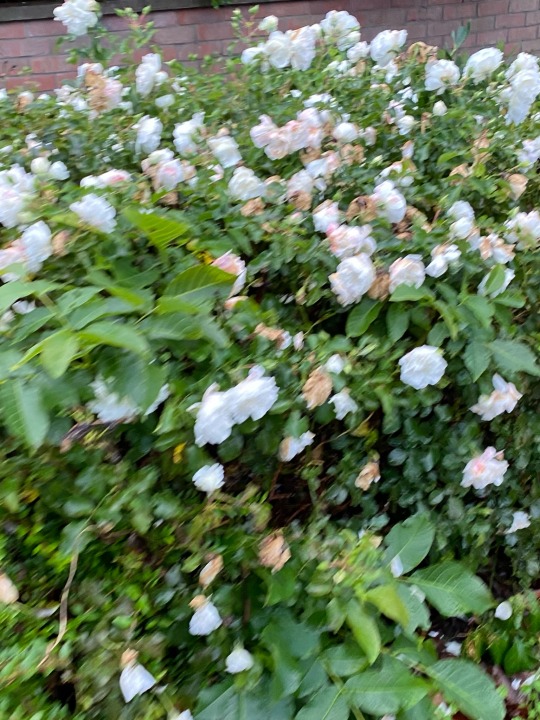




Digital print process to transfer over onto to fabric for our final piece
0 notes
Text
detailed research about Paula Ulargu: Siamese Skins. Two Nature. One Body
How she describes this project: “It's a sustainable development research inspired by this problematic anthropocene era and with the purpose of reconnecting humans to nature . Inspired by this need I tried to make clothing the tool for this reconnection... creating garments where the human body is the support for nature to grow, live and create its lifecycle” @paulaularguiescalona.com
for this collection she studied/researched and experimented with lots of seeds, plants, biomaterials.
Her aim for project Siamese skins. two nature. one body, was that its main result seeks to raise more awareness to create a more conscious and sustainable fashion industry.
the project is split into 3 branches of investigation: Mutualist Nature, Symbiotic Nature, Commensalism Nature
For my final piece I'm focusing and using the research only from two of the branches, symbiotic nature and commensalism nature.
Symbiotic Nature: meaning a close and persistent biological interaction between organisms of different species.
based around trying to grow plants in different fabrics, while taking into consideration of their needs for light, temperature and water
another priority of Paula Ularguis is the the aesthetic, for example picking the most tractive looking plants.
the process of everything coming together, meant that textile patterns wee an essential when selecting among them. Not only because its crucial they were aesthetically pleasing to the eye but also those that can keep the plants alive as long as possible.
what she wished to achieve overall when it came to wearing the garments, was the experience of nature in its first stages of life. In addition she also wanted to make these garments a second skin, a continuation of the wearers own biology. a direct connection between the two
Commensalism Nature: for or biological interaction in which one of the participants gets a benefit from the other without harm.
Paula Ulargui investigated with the Tillandsias, and found it to be a clear example of commensal nature.
The tillandsias are known to grow on plants trees or rocks. they benefit from the shade and humidity that rocks and trees provide. this links into the on going theme of coexistence.
This investigation project was focused of the tillandsia (also known as air moss) managing to weave, to create§the a garment that is permanently alive and even has the chance to flourish.
for her project she studied the practices of indigenous weaving (in loom with natural fibers).
0 notes
Text

Mind mapped and listed ideas to help with our final piece
0 notes
Text
Patchwork & Quilts
It’s said quilts stimulate memories of warmth, security and home yet their layer can also conceal hidden history or untold stories
History of quilts:
- history of quilting can be traced back to the medieval times. Early quilting was used for bed covers, it’s mentioned that fine quilts were kept as and became family heirlooms.
- In the sixteenth century silk and linen quilts became rather popular in wealthy households in Europe. An example of this would be Hebert VIII owned over one hundred quilts and quilted coverlets.
- Quilts were usually the work of women sewing domestically for their own use. However in other cases, quilts were made for necessity or to mark certain life occasions, such as weddings and births.



Patch work:
- Patch work and quilting is slightly different although being closely linked. Patchwork is a different needle work technique, with its own history.
- Patchwork or all’s known as ‘pierced work’ involves sewing pieces of fabric together to form and create a flat design.
- In Britain a common method of patchwork is known as ‘piecing over paper’. The technique works by the pattern first drawn into paper and then cut out. Small pieces of fabric is folded around each of the shaped paper and tacked into place. The shapes and then finally joined altogether from the back with the method of whipstitches.
- Another difference between quilting and patchwork is that, quilts are more commonly linked and associated with warmth and protection however patchwork is more related with domestic economy- using up scraps of fabrics or extending the working life of clothing.
- Patchwork was well known and adapted in the 1960s in the fashion industry, as a look associated with hippie culture.





0 notes
Text
Pattern magic - Jabara
Tomoko Nakamichi is behind the technique of Jabara. She teaches in a fashion school, with the success of her three books, due to her success with these books she has become one of the most well known fashion designers in Japan. Her inspiration come from nature, geometric shapes and from the street. It shows in her work that Master Tomoko Nakamichi’s designs take on creative silhouettes and forms.

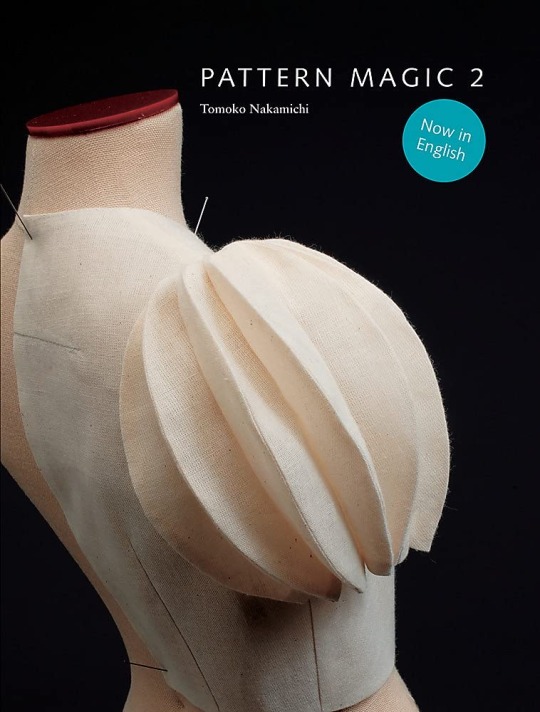




Jabara technique is from the pattern magic book two.
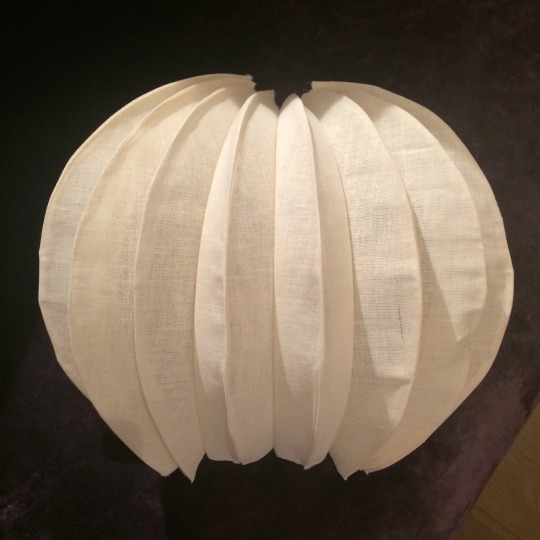

Technique of facings to go with Jabara
FACINGS-
- draw facings onto pattern of bodice 5cm wide
- Trace the facings onto other pattern paper and add seem allowance, then cute out of fabric
- Pin right sides of facing to right side of bodice
- Begin to stitch the fabrics
- Once sewn press seem open
- Fold facing to be on the inside of bodice and press flat
0 notes
Text
During our digital class we worked on mirrored prints from using photos of patterns and designs that we have already created in other workshops.

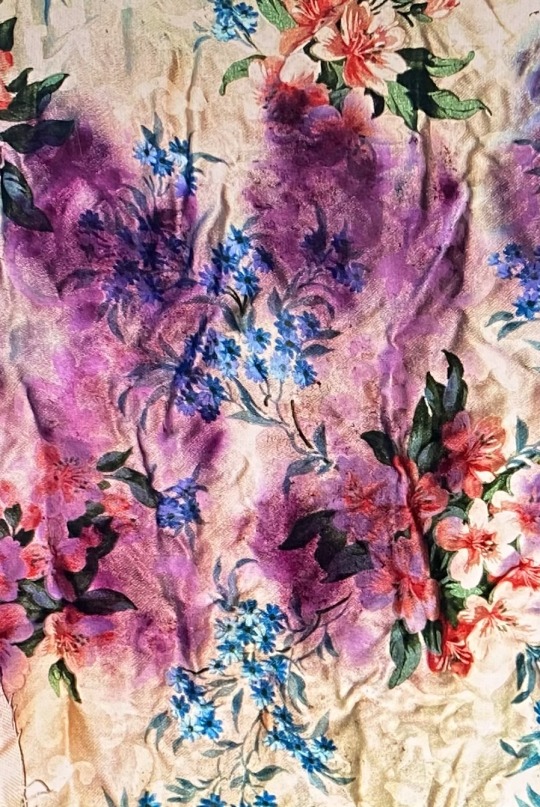

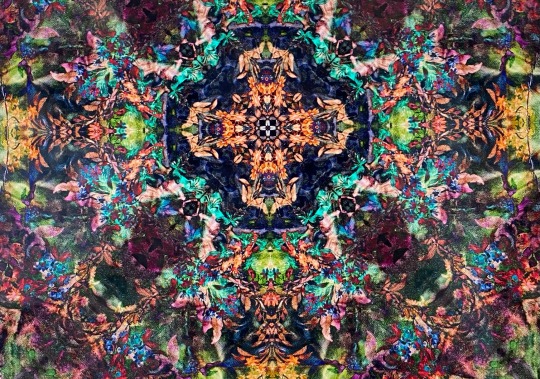

My first mirrored print was from my eco dye of blackberries, red cabbage.
We created the mirrored prints from using the app photoshop, which allowed us to rotate, flip, reflect and effects.
The idea of an mirrored print is that is ver similar to a repeat print but the difference is that everything lined up and merges together so it looks natural, making sure there are no lines to block and cut up the pattern.
Mirror repeat patterns are seen and used on all day to day things around your house and in your wardrobe for example it could be a design on a T-shirt or a pillow. However the thing to think about when transferring your pattern to something is how to line it up and show the best part of the pattern off.
Creating mirrored repeat patterns was something I enjoyed and would definitely be something I would experiment further with in the future. Where that is creating more or transferring it onto a product of my own.
0 notes
Text
My take on Eco dye
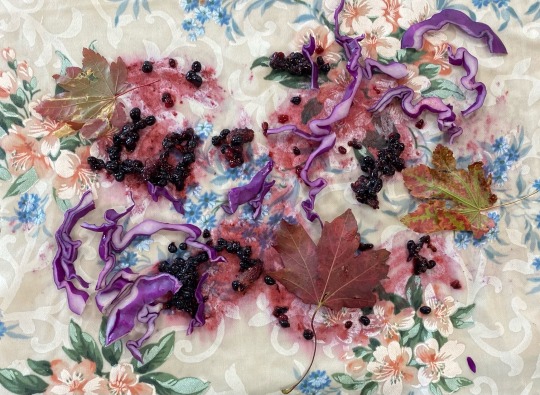

The first eco dye I experimented with was made up from black berries, red cabbage and leaves. The outcome shows that when taken out the steamer the leafs left no stain, but the black berries and cabbage left a more prominent colour stain. However I do believe the black berries still overpowered and was the stronger substances to cause a stain.
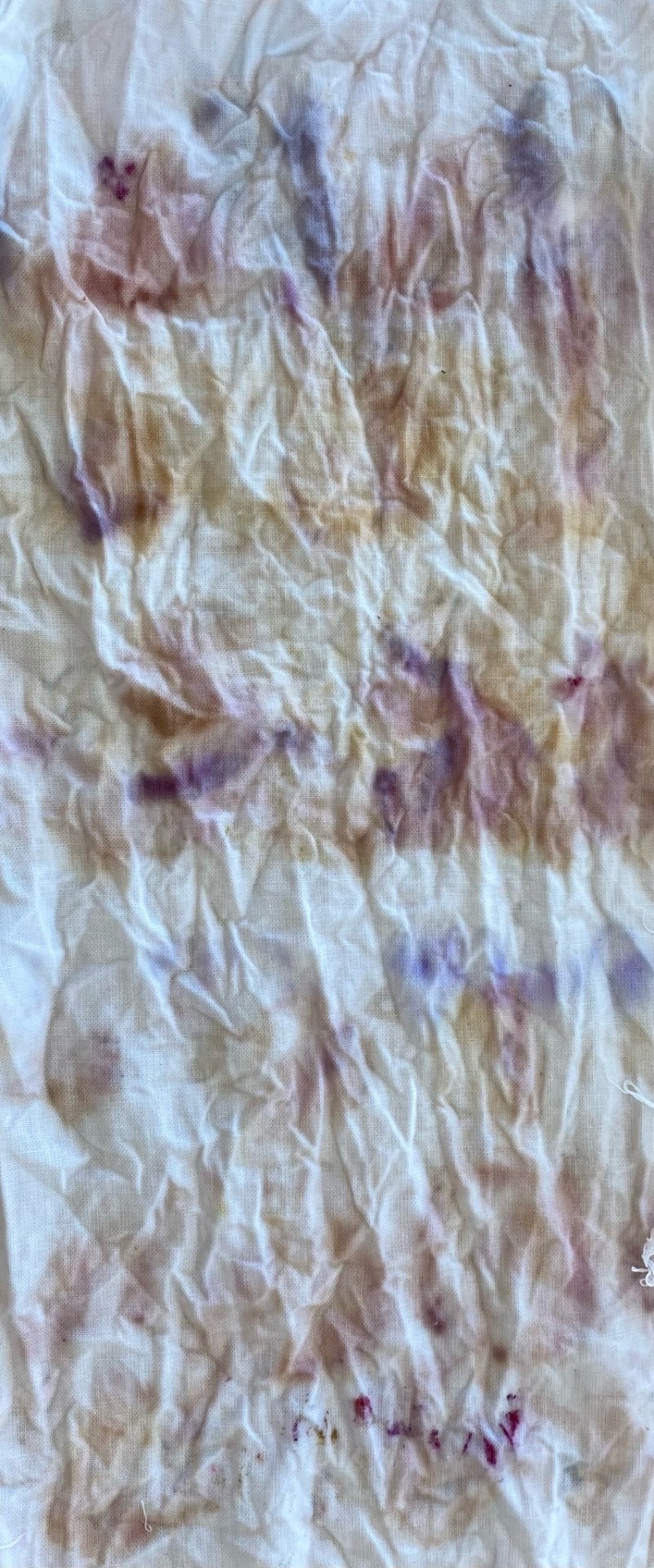
My second eco dye I used pink and purple flower petals. Although the dye isn’t the strongest in colour, I was still very happy with the outcome. As seen in the photo when steamed it produced a mixture of colours that compliment and work well together.

My third go at the technique of eco dyeing was the worst out of all four. For this eco dye I only used one product and that was the skin and seed of an avocado. Usually when using an part from the avocado it’s known to create a solid colour, however as you can see my failed and created quite the week stain. The colour air did produce were a mixture of a neutral orange/ beige and peach. I believe if I was to try again with avocado I would leave it longer in the steamer.
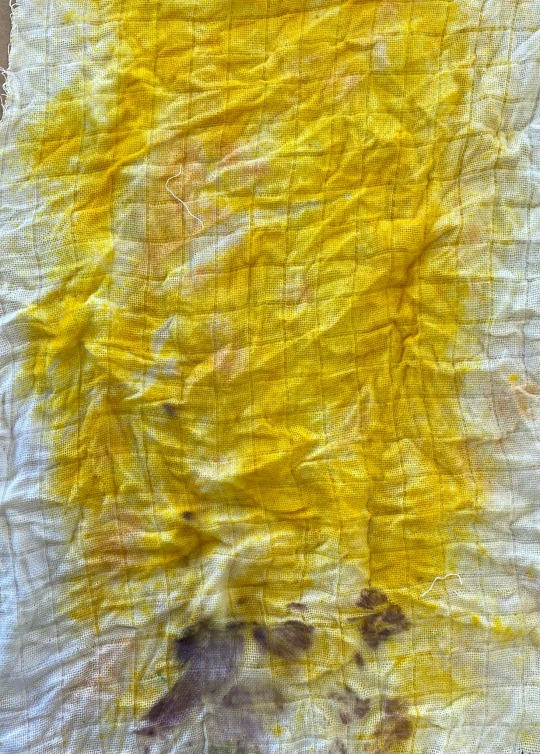
My final eco dye experiment was made up of turmeric and paprika on the inside of the fabric and once wrapped up I folded red onion skin round it. I found out of everything I played around with, that the turmeric and paprika produced the boldest and brightest dye. However due to the substances being in powered form it was hard to create and sort of pattern or structure as when rolled and wrapped the powders moved with the folding. I liked the combination of the dark purple and the yellow together and how they contrast each other by being so different, eg one being extremely bright and the other more dull and darker. If I knew the three products would create such beautiful colours that worked together well I would of added more onion skin, to help create more of a pattern or structure to this eco dye design.
0 notes
Text
Our next project was all about Eco dyeing. This links into the theme of regeneration through the use of environmental friendly or environmental items and products to create colour dye.
The Artist we took inspiration from was India Flint. She creates her art with natural substances, such as: dirt, leafs, flowers, vegetables or fruits. She tends to wrap her fabric or art in these substances and leaves them for a while allowing the clouds to transfer and dye the fabrics, allowing all different patterns a bd colours to emerge from the substances.
The second artist we took inspiration from was Paula Ulargui. Our inspiration from her was taken from the message she like to put forward to explain her technique and materials she uses for her art. For example her main idea and goal through her collections is the link between people and nature. During her work she tends to experiment with different types of seeds, plants, biomaterials and living organisms.
The technique we used followed hers very closely however, we applied our products onto the fabric and wrapped it up tightly and left it steaming in the steamer for up to at least an hour.
0 notes
Text
Subtraction cutting pt2







During this sessions we focused on experimenting with the use of the tunnel technique, and what happens when you use different size holes/ circles.
When cutting a larger hole it creates the opportunity and choice for your body to move through. Resulting in producing different silhouettes when worn.
However cutting smaller holes is used for decorative gathering.
The tunnel technique links into our project theme of regeneration by utilising as much fabric as possible and leaving little fabric waste.
0 notes
Text
Following the technique/ skill work of fabric dyeing, we worked on eco dye, where we use the environment or environmental friendly products, to create colour dye.
The artists that inspired our work are Indie Flint and Paula Ulargui.
0 notes
Text





In groups we had a go at following the tunnel technique on fabrics that we had drawn and printed on. This is only our starting point and we need to add more tunnels. In our group we played around with which fabric we wanted showing more at the from and which we wanted at the back.
0 notes





